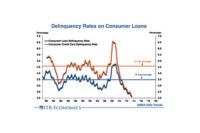The macroeconomic indicators for the U.S. economy are decidedly mixed. U.S. industrial production is growing at a slowing rate, as is U.S. gross domestic product, but the sluggishness in industrial production is more pronounced and thus makes the news cycle and impacts perception. The sluggish trends in manufacturing and mining will hinder robust growth in the overall economy into 2016. U.S. nondefense capital goods new orders, a proxy for business-to-business activity, is below the year-ago level, though the rate of decline to date, at 2.4 percent, is milder than normal (that’s the good news). A typical length of decline puts the end of the new orders downturn in March 2016. We attribute much of the decline to contraction within U.S. machinery new orders. In particular, U.S. Mining Machinery New Orders for the 12 months through August are down 34.3 percent from this time last year. These negative trends, coupled with the lower capacity utilization rates for manufacturing and mining, will constrain momentum within the U.S. for the next two quarters.
However, there are reasons for confidence for 2016 as there are some positive signs for our macro outlook. The majority of U.S. total retail sales sectors are positive. A strong consumer sector will carry the economy and provide HARDI members with willing and able customers on the residential side of the business. U.S. housing starts are on the rise, and U.S. retail sales for automobiles are strong. These indicators help confirm our expectations of overall consumer strength and signal that the consumer is willing to buy big-ticket items. Developing market trends in auto production will also aid resurgence in manufacturing for the overall U.S. economy in early 2016. The utilities segment of industrial production bumped up along with an increase in capacity utilization. The recent surge is the first since August of last year and is a good sign in the midst of a predominantly slowing economy.
Thus far, Federal Reserve has decided to leave interest rates at accommodative levels. Much of this is due to the lack of inflation. Inflation will probably remain relatively low for the next few quarters. Upward movement in commodity prices probably will precede rising inflation trends. The most recent Bureau of Labor Statistics employment data reported 142,000 new nonfarm jobs added for September and revised previous estimates for July and August downward by 59,000 jobs. This may also confirm the Federal Reserve’s rationale to postpone an interest rate hike. Remember, though, that there is an upside to a 25 basis point rise in the discount rate. A minor rate hike would signal the U.S. and global economy that the Fed sees a healthy economy that is on the move. A positive signal from the Fed could help decisions makers say “yes” to capital expenditures.
Although production is decelerating in the U.S. economy, there are no signs of recession. This trend will persist into the early parts of next year. However, mid-2016 will offer favorable economic conditions to facilitate robust growth within the U.S. This is a good time to use the low raw material input and low financing costs to optimize your production process to meet accelerating macroeconomic conditions next year.
HARDI members should note that the National Association of Homebuilders Index is signaling housing will be moving into phase C, slower growth, in 2016. This is consistent with ITR’s forecast. The rise in housing starts is expected to slow down, not break down, in the coming months.
On the bright side, the inventory of houses is enough to provide 4.7 months of sales (seasonally adjusted) as compared with the six to seven months for a more balanced market. A slightly tight inventory will help keep prices on a positive footing, which is good for sales through the near-term.
Office buildings saw vacancy edge lower to 16.4 percent nationally while rents inched higher by 0.6 percent; both are encouraging and welcomed trends. The annual growth rate in office building construction is a very healthy 27.4 percent with an annual spend rate of $44.9 billion. This is certainly good news for HARDI members. Please note that the rate of rise in the annual spend rate is about to slow but continue upward. We will take a national and regional look at office building and other construction segments at the annual meeting.
U.S. total value of retail and commercial construction renovation is 5.0 percent above year-ago levels, but the annual moving total (12MMT) is moving lower off a June 2015 high. The 3.6 percent decline is milder than median but still represents a decline in opportunity for HARDI members. A typical length of decline in the 12MMT would put the upcoming trough in February 2016. This would be consistent with our macroeconomics outlook. HARDI sales into the commercial renovation sector should improve in the second half of 2016.









